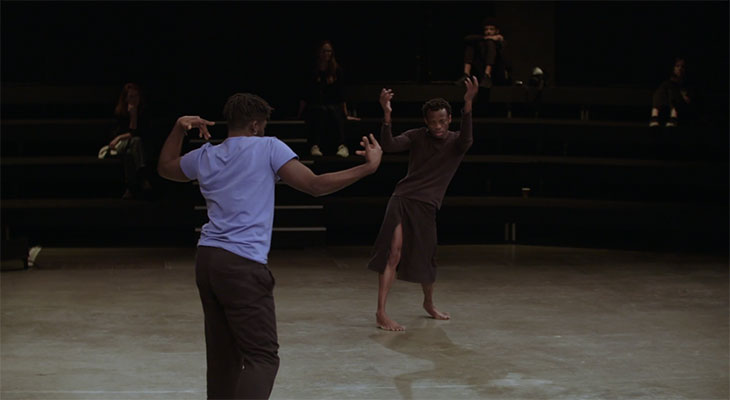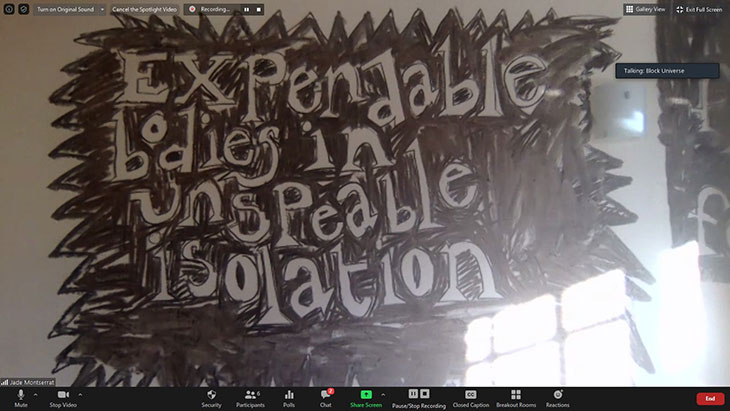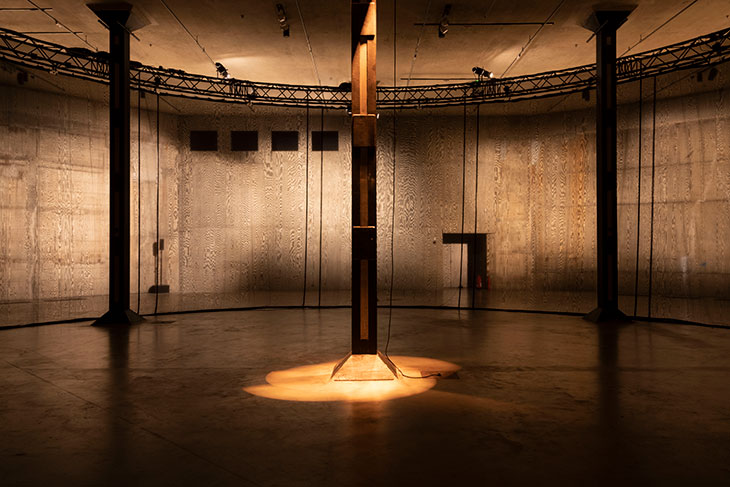In May 2020, the Royal Academy announced the year-long postponement of ‘Marina Abramović: After Life’. The first major UK retrospective of the renowned performance artist, and doyenne of highly public and routinely awkward social encounters, will not take place before autumn 2021. Distancing measures of the kind Covid-19 currently demands would misshape many of her key works and the institution’s strategy is to delay the exhibition until her repertoire can be accurately recreated and safely staged, while also focusing on fundraising efforts to offset loss of income during closure. The fallout of Covid-19 for the arts has been widespread, but what will the longer-term legacy be for the roving medium of performance art?
In recent months we have seen what might be understood as the first phase of adaptive measures, as many curators and producers transferred their performance programmes online. In late March, just as lockdown measures were announced in London, Tate Modern was forced to cancel the 2020 edition of its annual ten-day performance exhibition. Through the work of three notable black and indigenous artists – Faustin Linyekula, Okwui Okpokwasili and Tanya Lukin Linklater – the exhibition ‘Our Bodies, Our Archives’ set out to explore performance’s unique capacity to channel history through what Lukin Linklater describes as ‘a density of time held within the body’, a density that survives generations of colonialism and oppression. The last-minute cancellation of this endeavour seems doubly devastating as, within the current system, Covid-19 has disproportionately affected black and brown lives. In its place, Tate managed to film a new site-specific version of Linyekula’s My Body, My Archive in the Tanks, reinvented and combined with segments of previous works, Sur les traces de Dinozord (2006), Statue of Loss (2014), Banataba (2017) and Congo (2019).

My Body, My Archive (2020), Faustin Linyekula. Courtesy Tate
Similarly, from 25 to 30 May, the annual performance festival Block Universe presented ‘Sessions’, a five-day programme featuring workshops, videos, live music, performances and podcasts. Here domesticity was foregrounded in different ways: Jenny Moore, for example, performed People Are Unfinished (2020), a choreographed and musical set piece with her housemates, in a characteristically charismatic and ad hoc fashion. On another evening, Jade Montserrat conducted Drawing ‘Out’, ‘From’, ‘With’ – Lips Become The Surface (2020), a critical and inclusive drawing workshop in response to a reading by Nikita Gill.
The multi-venue Art Night, supposed to take place over the course of one night in June, was rescheduled for 2021 but as a placeholder, curator Helen Nisbet lined up a series of artwork ‘trailers’ to be viewed one Saturday evening with suggested recipes for baked aubergines and elderflower cocktails. Here an array of approaches included snippets of performances-in-progress by Isabel Lewis and Oona Doherty, and a video work by Alberta Whittle responding to police brutality in the wake of Black Lives Matter protests. Holding the Line (2020), Whittle recommended, should be watched with a candle lit and the viewer’s body comfortably reclined. These online programmes championed the creative possibilities of domestic intimacy, but also highlighted the political deceits of the Tory slogan ‘we’re all in this together’.
Notably, this first phase of response to Covid-19 has proven the indispensability of recording technologies in the various stages of a performance’s life cycle and the nuanced ways in which such recordings can be made public. Thus, the nobility of ‘liveness’ in performance works (as opposed to examples supported by or dependent on documentation), a quality long theorised as foundational to the medium, has never felt more outdated.

Screenshot from Jade Montserrat and Nikita Gill’s Drawing ‘Out’, ‘From’, ‘With’ – Lips Become The Surface (2020). Courtesy Block Universe
At the time of writing galleries and museums are tentatively reopening alongside schools, universities and other cultural spaces. Retrospection and introspection seem necessary as we move forward into Covid-19’s indefinite present. It seems likely there will be many serious changes for performance: formally, infrastructurally and economically. Some of these changes may not be bad. In a recent letter to MoMA Magazine reflecting on the current situation (published as part of its ‘Performing at a Distance’ series), Anne Teresa De Keersmaeker asks, ‘What would it even mean to hold a performance with 30 dancers observing social distancing? These protocols, after all, are about more than physical distancing; as we see, they are about the very absence of the relationships created by placing bodies in the same space.’ A more solitary form of dance, she imagines, is what lies ahead: ‘Solos and monologues will flourish; the lone dancer is bound to become the figure of a new aesthetics.’ Performance will surely reflect and likely probe new modes of contact and forms of sociability in a world irrevocably altered, and not only through dance, but also through performance’s other tributaries, in public interventions, lecture and sound performances, spoken word, readings, staged encounters, improvisations and installation.
Infrastructurally, certainly in the short term, the conditions in which performance is rehearsed, staged and viewed will be modified. But that architectural model of what performance art curator Catherine Wood and art historian Claire Bishop have referred to as a ‘grey zone’, the hybrid space between art’s white cube and theatre’s black box, is itself novel. Performance in contemporary art significantly predates the architectures recently adapted to host it. Nomadic and illusive, it has often been pointedly difficult to contain, and openly communicative of its scepticism of the commercial gallery and the museum in cahoots with capitalism and neoliberalism. Yvonne Rainer and her peers took their innovative performances to the Judson Memorial Church; Robert Rauschenberg brought his collaborators to a roller-skating rink, then tennis courts, then later, most ambitiously, Santa Monica Pier and its flanking car park (that last project ultimately remained unrealised). In the 1970s, Trisha Brown danced on the rooftops of New York and Joan Jonas wheeled bodies along the docks by the Hudson River. A suited Pope.L crawled the sidewalks of that same city, where Adrian Piper had taken to pronouncing her mantras in drag. More recently, Boris Charmatz’s troupe has split crowds gathered in urban centres, and Tania Bruguera and Ai Weiwei continually aim their public interventions at the machineries of global propaganda. On street corners, rooftops, and foyers, in documentation, media reportage, and online, performance has a long history of boxing clever, and as long a history of doing so assertively outside the box. Given this historical context, adapting to newly modified architectures seems the least monstrous of performance’s impending tasks.

The Tanks, where the annual BMW Tate Live exhibition takes place, at Tate Modern. Photo: © Tate Photography, Oliver Cowling, 2020
But anecdotal reassurances and recent online contingencies aside, the future of performance as a meaningful, socially attentive medium hangs in the balance. And this is not only because of inevitable further cuts to public funding and knocks to the art market, both of which will impact on the financial support streams coming to designated artists through established institutional channels. It’s what’s outside, before and beyond these channels that is most at risk. As recession hits and redundancies abound, as art colleges, museums and other cultural venues lay off front-line staff, it’s important to register that these staff have names, and that some of them are the names of the artists of our future. Many such precarious workers represent our cities’ emerging and mid-career artists, as well as independent curators, critics and producers. Often, these are the individuals disproportionately affected by the virus and its economic fallout: black artists and artists of colour, trans and queer artists, differently abled and lower-income artists. Arguably, these are the artists our future needs the most. If ‘solidarity’ has been one of the most frequently used hashtags during the pandemic, it calls upon art’s entire ecosystem – me, you, our institutions, readers and audiences – to make sure its utterance is not some empty performance.
Isobel Harbison is an art critic and lecturer in critical studies in the art department at Goldsmiths, University of London. She is the author of Performing Image (The MIT Press).

What does the pandemic mean for the future of performance art?
Marina Abramović performing The Artist Is Present at the Museum of Modern Art, New York, 2010. Photo: Andrew H. Walker/Getty Images
Share
In May 2020, the Royal Academy announced the year-long postponement of ‘Marina Abramović: After Life’. The first major UK retrospective of the renowned performance artist, and doyenne of highly public and routinely awkward social encounters, will not take place before autumn 2021. Distancing measures of the kind Covid-19 currently demands would misshape many of her key works and the institution’s strategy is to delay the exhibition until her repertoire can be accurately recreated and safely staged, while also focusing on fundraising efforts to offset loss of income during closure. The fallout of Covid-19 for the arts has been widespread, but what will the longer-term legacy be for the roving medium of performance art?
In recent months we have seen what might be understood as the first phase of adaptive measures, as many curators and producers transferred their performance programmes online. In late March, just as lockdown measures were announced in London, Tate Modern was forced to cancel the 2020 edition of its annual ten-day performance exhibition. Through the work of three notable black and indigenous artists – Faustin Linyekula, Okwui Okpokwasili and Tanya Lukin Linklater – the exhibition ‘Our Bodies, Our Archives’ set out to explore performance’s unique capacity to channel history through what Lukin Linklater describes as ‘a density of time held within the body’, a density that survives generations of colonialism and oppression. The last-minute cancellation of this endeavour seems doubly devastating as, within the current system, Covid-19 has disproportionately affected black and brown lives. In its place, Tate managed to film a new site-specific version of Linyekula’s My Body, My Archive in the Tanks, reinvented and combined with segments of previous works, Sur les traces de Dinozord (2006), Statue of Loss (2014), Banataba (2017) and Congo (2019).
My Body, My Archive (2020), Faustin Linyekula. Courtesy Tate
Similarly, from 25 to 30 May, the annual performance festival Block Universe presented ‘Sessions’, a five-day programme featuring workshops, videos, live music, performances and podcasts. Here domesticity was foregrounded in different ways: Jenny Moore, for example, performed People Are Unfinished (2020), a choreographed and musical set piece with her housemates, in a characteristically charismatic and ad hoc fashion. On another evening, Jade Montserrat conducted Drawing ‘Out’, ‘From’, ‘With’ – Lips Become The Surface (2020), a critical and inclusive drawing workshop in response to a reading by Nikita Gill.
The multi-venue Art Night, supposed to take place over the course of one night in June, was rescheduled for 2021 but as a placeholder, curator Helen Nisbet lined up a series of artwork ‘trailers’ to be viewed one Saturday evening with suggested recipes for baked aubergines and elderflower cocktails. Here an array of approaches included snippets of performances-in-progress by Isabel Lewis and Oona Doherty, and a video work by Alberta Whittle responding to police brutality in the wake of Black Lives Matter protests. Holding the Line (2020), Whittle recommended, should be watched with a candle lit and the viewer’s body comfortably reclined. These online programmes championed the creative possibilities of domestic intimacy, but also highlighted the political deceits of the Tory slogan ‘we’re all in this together’.
Notably, this first phase of response to Covid-19 has proven the indispensability of recording technologies in the various stages of a performance’s life cycle and the nuanced ways in which such recordings can be made public. Thus, the nobility of ‘liveness’ in performance works (as opposed to examples supported by or dependent on documentation), a quality long theorised as foundational to the medium, has never felt more outdated.
Screenshot from Jade Montserrat and Nikita Gill’s Drawing ‘Out’, ‘From’, ‘With’ – Lips Become The Surface (2020). Courtesy Block Universe
At the time of writing galleries and museums are tentatively reopening alongside schools, universities and other cultural spaces. Retrospection and introspection seem necessary as we move forward into Covid-19’s indefinite present. It seems likely there will be many serious changes for performance: formally, infrastructurally and economically. Some of these changes may not be bad. In a recent letter to MoMA Magazine reflecting on the current situation (published as part of its ‘Performing at a Distance’ series), Anne Teresa De Keersmaeker asks, ‘What would it even mean to hold a performance with 30 dancers observing social distancing? These protocols, after all, are about more than physical distancing; as we see, they are about the very absence of the relationships created by placing bodies in the same space.’ A more solitary form of dance, she imagines, is what lies ahead: ‘Solos and monologues will flourish; the lone dancer is bound to become the figure of a new aesthetics.’ Performance will surely reflect and likely probe new modes of contact and forms of sociability in a world irrevocably altered, and not only through dance, but also through performance’s other tributaries, in public interventions, lecture and sound performances, spoken word, readings, staged encounters, improvisations and installation.
Infrastructurally, certainly in the short term, the conditions in which performance is rehearsed, staged and viewed will be modified. But that architectural model of what performance art curator Catherine Wood and art historian Claire Bishop have referred to as a ‘grey zone’, the hybrid space between art’s white cube and theatre’s black box, is itself novel. Performance in contemporary art significantly predates the architectures recently adapted to host it. Nomadic and illusive, it has often been pointedly difficult to contain, and openly communicative of its scepticism of the commercial gallery and the museum in cahoots with capitalism and neoliberalism. Yvonne Rainer and her peers took their innovative performances to the Judson Memorial Church; Robert Rauschenberg brought his collaborators to a roller-skating rink, then tennis courts, then later, most ambitiously, Santa Monica Pier and its flanking car park (that last project ultimately remained unrealised). In the 1970s, Trisha Brown danced on the rooftops of New York and Joan Jonas wheeled bodies along the docks by the Hudson River. A suited Pope.L crawled the sidewalks of that same city, where Adrian Piper had taken to pronouncing her mantras in drag. More recently, Boris Charmatz’s troupe has split crowds gathered in urban centres, and Tania Bruguera and Ai Weiwei continually aim their public interventions at the machineries of global propaganda. On street corners, rooftops, and foyers, in documentation, media reportage, and online, performance has a long history of boxing clever, and as long a history of doing so assertively outside the box. Given this historical context, adapting to newly modified architectures seems the least monstrous of performance’s impending tasks.
The Tanks, where the annual BMW Tate Live exhibition takes place, at Tate Modern. Photo: © Tate Photography, Oliver Cowling, 2020
But anecdotal reassurances and recent online contingencies aside, the future of performance as a meaningful, socially attentive medium hangs in the balance. And this is not only because of inevitable further cuts to public funding and knocks to the art market, both of which will impact on the financial support streams coming to designated artists through established institutional channels. It’s what’s outside, before and beyond these channels that is most at risk. As recession hits and redundancies abound, as art colleges, museums and other cultural venues lay off front-line staff, it’s important to register that these staff have names, and that some of them are the names of the artists of our future. Many such precarious workers represent our cities’ emerging and mid-career artists, as well as independent curators, critics and producers. Often, these are the individuals disproportionately affected by the virus and its economic fallout: black artists and artists of colour, trans and queer artists, differently abled and lower-income artists. Arguably, these are the artists our future needs the most. If ‘solidarity’ has been one of the most frequently used hashtags during the pandemic, it calls upon art’s entire ecosystem – me, you, our institutions, readers and audiences – to make sure its utterance is not some empty performance.
Isobel Harbison is an art critic and lecturer in critical studies in the art department at Goldsmiths, University of London. She is the author of Performing Image (The MIT Press).
Unlimited access from just $16 every 3 months
Subscribe to get unlimited and exclusive access to the top art stories, interviews and exhibition reviews.
Share
Recommended for you
Performance art costs a lot to produce – but can it make money, too?
The status of performance may be on the up, but its place in the art market is still precarious
‘I was storing crates in my dining room’ – on launching a gallery during lockdown
Setting a brave example wasn’t what Niru Ratnam had in mind when he forged ahead with plans to open his new business during the pandemic
Lessons from a lonely city – walking through lockdown London has been a revelation
We’re all flâneurs now. So what would help us get even more out of walking through our local areas?